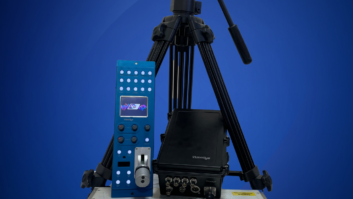Choosing the right camera can be a complex process, and represents a significant investment for any media organisation. There are several long-term strategic and commercial considerations to weigh up when investigating the options available. It’s critical to make the best choices to fit your organisation’s needs, requirements, and future roadmap, but what are the key questions you need to ask yourself, and what are the main factors to consider when it comes to purchasing live broadcast cameras?
Pressures in today’s environment
The media market is evolving at speed. Research commissioned by advertising specialist Thinkbox found that viewing increased by 40 minutes per person per day in 2020 over 2019, with broadcast television accounting for 64 per cent of the total.
Demand for television is strong. Within that, live video is the most prized form of content in our industry, and the most challenging to deliver. There are no second chances with live production, so it’s essential you have the best media workflows at your disposal, and the camera is where it all starts.
Nowadays, consumers expect live media delivered across an ever-increasing number of platforms. Supporting a rapidly expanding range of distribution options is challenging and requires additional time and equipment expenditures.
Furthermore, the cost of producing live content is rising. Sports federations expect ever-higher payments for media rights, while global audiences demand continued innovation in production values. After an action-packed summer of live sports content produced in 4K UHD, such as UEFA Euro 2020 and the Tokyo 2020 Olympics, fans are hungry for more immersive viewing experiences.
Delivering these enhanced media experiences often requires additional solutions, and increased infrastructure bandwidth for improved picture quality.
The IP revolution
Major media enterprises recognise the transformational potential of IP-based platforms, enabling greater scalability and flexibility across production and distribution. For many years, an SDI interface was the only method to transmit a steady stream at what was then considered a high speed. What once required bespoke hardware connected via SDI is now replaced by IP connectivity. Due to advances in IP, video and audio signals can now be transmitted with much higher bandwidth and over greater distances, using readily available IP networking solutions.
Innovation in IP-enabled camera technology means media companies can seamlessly transition to IP-focussed models. Camera solutions with built-in native IP connectivity can connect over a standard SMPTE hybrid fibre cable, enabling easy and quick adoption across sports venues worldwide. With native SMPTE ST 2110 IP outputs, these cameras can connect directly to your data infrastructure. If your facility has already made the move to live IP production, you eliminate the need for the bulky CCU, as uncompressed or compressed streams can now connect directly to your IP networking.
There is now a widely recognised suite of interoperability standards, meaning the migration towards IP connectivity can be a seamless and secure proposition. But SDI and IP will co-exist for many years to come; this is a gradual transition and not an overnight revolution. Therefore, media technology workflows must be designed to work in a hybrid environment. The migration to IP is no one-size-fits-all process and many companies are at differing stages and paces of their transition. The ability to operate on a production-by-production basis, leveraging technology platforms that can handle outputs in SDI, IP, or any hybrid form, is critical.
A new commercial approach
The shift to software-centric technology workflows has brought about new commercial considerations in the media market. Traditional media equipment was mainly fixed in functionality and scale and regarded as a capital investment with a typical working life of five to seven years.
Software systems running on standard computer hardware have a different commercial model. Media organisations are increasingly adopting software-centric solutions, moving away from a heavy capex model favouring an opex-based approach, enabling enhanced business agility and commercial flexibility.
Software for media-specific functionality can be routinely updated and extended, with the option of additional feature sets and licensed for a specified period.
Licensing software typically transforms a purchase model from a significant upfront payment based on the largest expected capacity of a system to smaller incremental payments based on evolving requirements. This helps preserve cashflows for other investments, and enables a much better ROI of content, as licences for additional functionality or capacity can be directly linked to specific projects, creating a clear link between revenues and opex outlay.
Due to advances in cloud- and software-based solutions, considerable amounts of a media organisation’s technology platform can be delivered via SaaS workflows. Software applications play a fundamental role within the broadcast camera, providing extensive operational functionality housed within the device-specific hardware. However, the requirement for some bespoke hardware, such as the broadcast camera itself, is naturally clear. You can’t virtualise a broadcast camera… at least, not yet.
Decision time
Fundamentally, when choosing a camera, you want to be sure that it meets your creative and technical requirements, both today and in the future, so you will be asking questions like:
- Can the camera support HD and 4K UHD?
- How important is high dynamic range and extended colour gamut for my operation?
- Do I need to create high-quality slow-motion replays from the camera, requiring a high frame rate?
- Will my cameras operate on an SDI network or over IP?
- Will I use the cameras locally – in a studio or directly connected to a remote production truck – or as part of a distributed production model?
Answering these key questions is essential. You are still making a significant financial spend with camera purchases as this kit is rarely bought individually.
Leading media companies and content creators require camera solutions to deliver uncompromised image quality and fuel creative flair with high-quality slow-motion replay and advanced colour grading capabilities. Broadcast cameras must meet the demands of both today and tomorrow, ensuring seamless compatibility with existing workflows (such as standard lenses and mounts for tripods, pedestals and cranes, as well as existing base stations) while future-proofing operations and driving innovation in the long run.
At Grass Valley, our mission is delivering on these key considerations for companies across the media market, and ensuring customers have access to the right camera solutions, at the right stage of their technology roadmaps, to continue to deliver premium live content.







